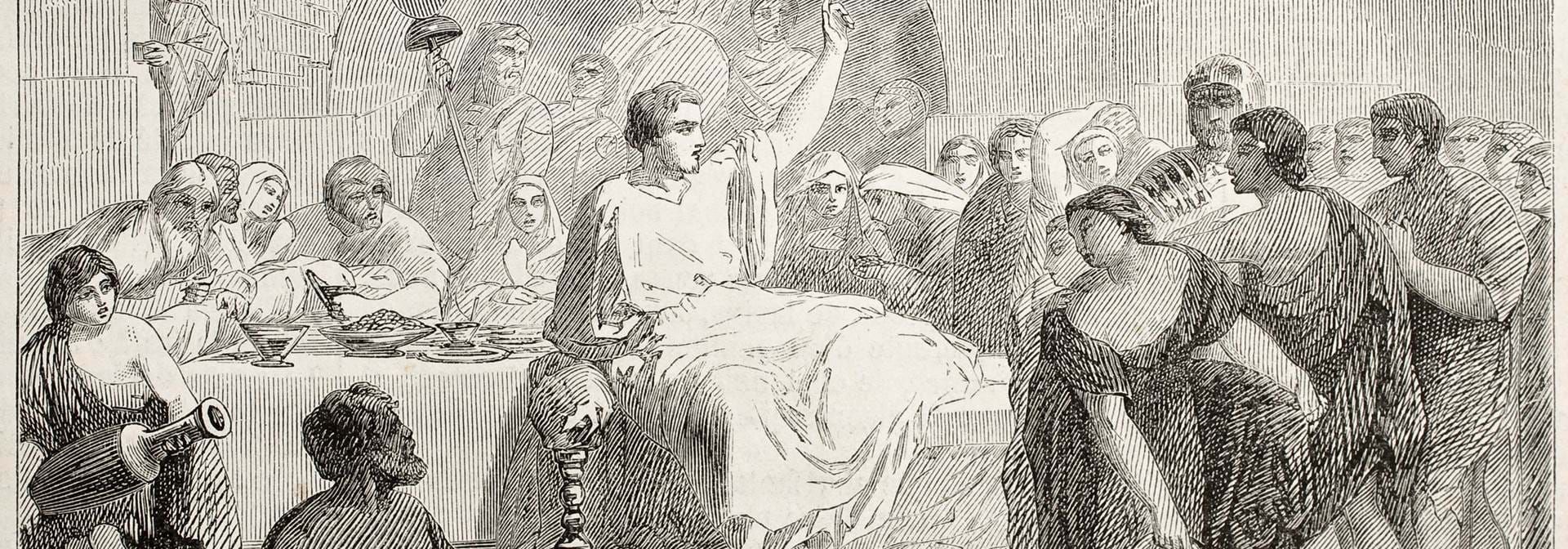Guess who’s coming to dinner?

If you’ve ever wondered what a Roman dinner is like, imagine sophisticated conversation, recitations of poetry and gentle music performed by flute. However, some gatherings were just as likely to involve raucous drinking, naked tightrope walkers and vulgar ostentation.
Traditionally thrown in the early evening, after a visit to the baths and an afternoon of fun and games, the Roman dinner party was one of the most important pieces of social and political cement in the Republic and Empire.
The classic account of a dinner comes from the time of Nero, himself well known for revolving dining rooms and ornamental wine fountains and was left to us by an author named Petronius. His book, the Satyricon, is as the name suggests a sport of fictionalised satire with exaggerated characters and situations. The surviving section, Dinner with Trimalchio, recounts the hero’s attendance at a lavish dinner thrown by a ghastly, gauche, nuovo riche freedman. It became a central piece in the famous film version of the book, which was directed by Federico Fellini.
Our picture shows a slightly later illustration of a Roman dinner. This dates to the 3rd century AD and is from the Roman east, so many of its details are Hellenised rather than strictly Roman, but the gradual adoption of eastern styles was the way forward for the fashionable. Here, the traditional three couches of the dining room (triclinium) have been replaced by a stibadium, which is a circular couch. Being pragmatic the Romans then created an arrangement of three stibadium couches in especially designed three-apsed rooms.
The diners are men, most dinner parties were men-only occasions, traditionally women sat decorously on chairs at a table to the side, though women could accompany their menfolk, whether as wives or courtesans. Many images of dinners show exuberant carousing, though this may have been a convention. A large ceramic wine cup from Italy bears the inscription, ‘I am called the friend of a friend, drink from me to be sure’ with a small graffito of a stork, a bird associated with drunkenness. But this cup is enormous and clearly a novelty, akin to the ‘yard of ale’ in English pubs.
Our diners are a mixture, some quaffing from bottles, others engaged in pointed conversation, one clearly having drunk too much is half asleep, it is an animated scene, with servants pouring wine from a bronze ewer and some diners walking around and stretching their legs and is perhaps the most realistic part of the mosaic.
The littered and dirty floor is striking. Diners are clearly just throwing away oddments of food, half-chewed bones, fruit cores, over the elegant floor, while the household cat has a field day. While this is somewhat exaggerated, there was a famous series of mosaics showing an unswept floor which were popular as elaborate jests from the age of Alexander onwards.
So, elegant or crude? I suppose it depended to some degree on your social circle, only those with at least some money engaged in the elaborate hierarchical game of the formal banquet.
History Tours
NEWSLETTER
Opt-in to our email newsletter and hear about new offers first – view our privacy policy for details.



